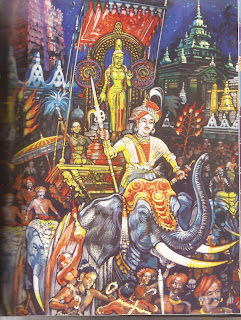
Picture shows Cheran Senguttuvan's Procession with Kannaki statue
Please read first two parts 1.Who was Tolkappiar? And 2.Did Tolkappiar copy from Sanskrit sources? Following excerpt is Third Part:- swami
Prof. S. Vaiyapuri Pillai continues:
“Besides the poetic themes, the third section of Tolkappiyam contains a subsection on sentiments and their physical manifestations, another on figure of speech, a third on prosody and, finally, a subsection on literary usage. These subsections show a master mind of extraordinary profundity of learning. The chapters on sentiment and figures of speech no doubt based upon works like Bharatanatya Sastra; but the treatment showsa rare inwardness, a brilliant expository power and a crystal clear formulation peculiar to the author. His sub sections on prosody and on literary usage are master pieces of their kind. His deep knowledge of the works of the earlier grammarians, his thoroughness on the mechanistic side of prosody and his accuracy in ascertaining the usage of words have not been approached by any grammarian since his time.
More than twenty works on grammar are cited in the valuable commentary on Yapparungalam. But none of them definitely is earlier than Tolkappiam”. (Vaiyapuri Pillai also gives reasons for his conclusion).
Tolkappiyan Statue in Indonesia
Mr A Kalyanaraman in his book Aryatarangini, Volume 1, Page 51 says.
“The Tolkaapiam is full of material, showing strong parallelism with corresponding in Sanskrit grammatical and other works: the number of Sanskrit words used in the Tamil work, is also large, as is the case with ancient Tamil works generally, a laboured attempt at finding an equivalent ‘southern word’ is often in evidence.
( 35 items are mentioned by Charaka, and 32 by Kautilya, as the prime requisites of a literary composition. Of these items, technically known as ‘tantra yuktis’ , the Tolkappiyam enumerates 32 in Porul Adhikaram, 22 of which coincide with those of Kautilya).
Some sutras of Tolkappiam are of special significance in this context. For instance, sutras 142 and 143 read as follows:
Sutra 142 of Porul Adhikaram translation:
“There was ,once upon a time, when the karanam as enjoined on the three highest (castes), began to be applied to the lowest (caste) also”.
Sutra 143 translation:
“ They say that karanam was introduced by Aryans, after lovers began to be false, and the ladies were considered unworthy.”
Karanam in the above sutras, refers to the rite of Agnikaranam or the Daiva, Brahma forms of marriage before the sacred fire, prescribed by manu and other Smritikaras, as the best form of nuptials.
(Aiyan in the Tamil sutra is Aryan in Sanskrit)
Tolkappiyanar whose Sanskrit name was Trinabindu, was a follower of Agastya. A sculpture of Trinabindu, with this name written in Nagari script has been found in Java, in an Agastya shrine of the 8[SUP]th[/SUP] century AD.
My Opinion
(My personal view is Silappadikaram, Tolkappiyam and Tirukkural all these belong to the dark period of Tamil Nadu-4[SUP]th[/SUP] century AD. All the three have the Sanskrit word ADHIKARAM. But the rules mentioned by Tolkappiar were ancient. That is the reason he says hundreds of times, “They say”, “it is said that”—journalist’s language to show that he was not the one who codified all the rules. There is internal evidence to prove it. I have given a lot of examples in my five part Tamil article.)
No linguist can push back the date of Tolkappiar beyond 1[SUP]st[/SUP] Century BC. We know his style and the language that is found in Tolkappiam and the verse of Panamparanar, his contemporary. We have the verses composed by poets of first and second Tamil Sangam in the Sangam anthologies. We don’t see any change in the style or language. So they belong to the first few centuries.
(Please read my post: 3 Tamil Sangams Myth and Reality)
Max Muller followed a theory that a language changes every 200 years when he fixed the age of the Vedas. Whether he is right or wrong, we know that the style of Sangam Anthologies, Silappadikaram, Tirukkural and Thevaram are different from one another. Language is not stagnant. Even when we have printed media, the language keeps on changing. Every one of us knows Tiruvalluvar can’t read Today’s Tirukkural book. Tamil script has changed in 1500 years.
The words used by Tolkappiar betray his age. The concepts (borrowed from Sanskrit books) he followed betray his age. But we should never forget that he compiled a grammar faithfully that existed long before him. Like Veda Vyasa compiled Vedas, he compiled the old rules. Tolkappiar gives 38 ‘Uvamai Urupu’( particles of comparison:- like, as, similar and such words used to compare with another). But only 24 of the 38 are used by Sangam poets. And Sangam poets added another 28 new ones. So we can conclude that Tolkappiar had compiled only that existed before his time.
One may try to push back the age of Tolkaapiar by saying that 14 Uvama Urupus lost coinage by the time of Third Tamil Sangam and 28 new Uvama Urupus were added by the Sangam poets and so a lot of time must have lapsed between his time and the time of Tamil Sangam. Since his language and style are not that old, this argument won’t be accepted by linguists. Even a Tamil living today can understand his simple language. Contact [email protected]
****************
